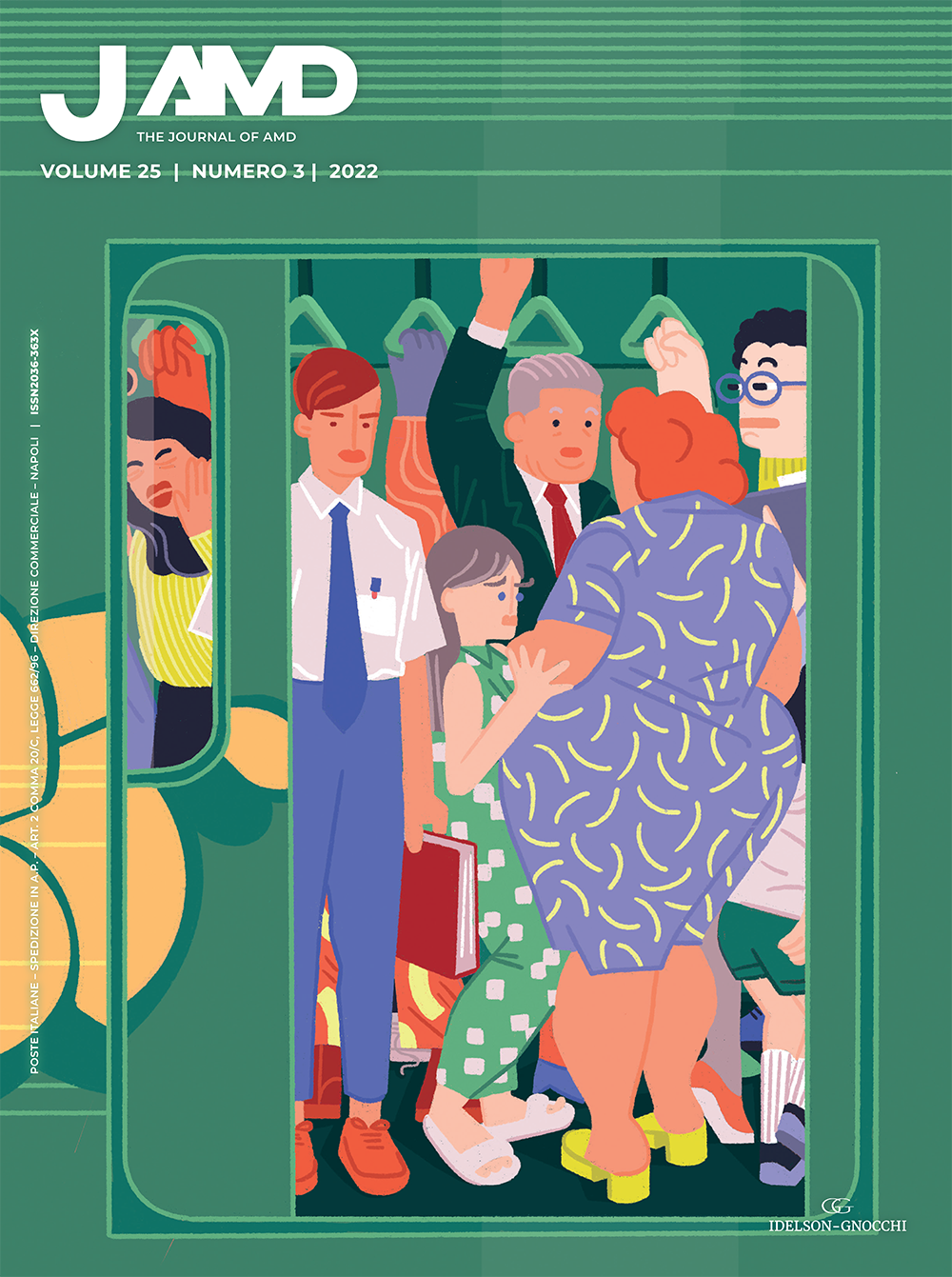Editorial
ABCD treatment: a new paradigm?
JAMD 2022;25(3):148-149
Reviews
Non-insulin therapy in diabetic inpatients: SGLT2- inhibitors and incretins for the care of hospitalized patients
JAMD 2022;25(3):150-163
Hyperglycemia is a common event in hospitalized patients and it is an independent marker of morbidity and mortality in both critically and non-critically ill patients. Maintaining a good glycemic control in the hospital setting improves patient outcomes and reduce costs of hospitalization.
The insulin therapy has so far been the main hypoglycemic treatment used in the hospital setting, but it requires trained healthcare personnel and can determine a non-negligible risk of hypoglycemia.
In the recent years the use of hypoglycemic drugs with innovative mechanisms of action, such as glycosurics (the sodium-glucose co-transporter 2 inhibitors, SGLT2-i) and incretinomimetics (the agonists of the glucagon – like peptide – 1, GLP-1 RA, and dipeptidyl-peptidase IV inhibitors, DPP4-I) has increased in diabetic outpatient care. Nowadays the use of these drugs is recommended by the most recent guidelines on the management of diabetes for the notable advantages in terms of cardiovascular safety and efficacy.
However, there are still few data available on their use in inpatients that could support their adoption in routine clinical practice. A wider consumption of these drugs could notably reduce the need for insulin therapy in hospital, even if it is important to consider possible side effects and availability in the hospital formulary.
The purpose of this review is to analyze data from the international literature on possible indications and limitations of glycosurics and incretinomimetics in the hospital setting, particularly regard safety and tolerability in some specific contexts.
We can conclude that it is reasonable to propose the use of glycosurics and incretinomimetics in non-critical patients with specific comorbidities DPP4-I in elderly and frail patients or with renal insufficiency; GLP1-RA in patients in secondary prevention or with high cardiovascular risk; SGLT2-i in patients with heart failure.
KEYWORDS diabetes; inpatient; therapy; incretinomimetics; glycosurics.
Original articles
SGLT2-inhibithors in frail older people with type 2 diabetes
JAMD 2022;25(3):164-169
Many studies have provided compelling evidence of efficacy and safety of SGLT2 inhibitors (Sglt2-i) both for glycemic control and for reducing risk of cardiovascular and renal outcomes in type 2 diabetic patients. An extensive use of these molecules in high-risk people – as elderly people are – would be theoretically desirable. However only on a real-world setting this class of drugs are underused in elderly patients because of physician’s concerns about efficacy and safety of SGLT2-i, in vulnerable and frail people. Our article aimed to evaluate current evidence about long-term efficacy and safety of SGLT-i in frail-older patients with type 2 diabetes. Current evidence suggest frailty should not be considered as limiting factor in the use of SGLT2 inhibitors which, on the other hand, could represent an opportunity to improve the quality of life (e.g. reduction of hospitalizations for SCC) in most frail patients. However, careful clinical evaluations should be recommended to minimize the risk of adverse effects.
KEYWORDS frailty; older people; safety; SGLT2-i.
Remote monitoring of gestational diabetes with my Sugr App integrated to diabetology EMR during Covid-19 emergency
JAMD 2022;25(3):170-174
The aim of our study was demonstrate how the implementation of a shared management process using innovative tools, such as telemonitoring with a mobile app, has a benefits in term of facilitating the management of women with GD and reducing access to hospitals.
Due to COVID-19 emergency in 2020, the integration between the Diabetologist EMR (SDC) and mySugr app for people with diabetes was activated for 4 months; the patient can enter blood sugar and other clinical data in the app for recording and tracking data directly in the EMR. The telemonitoring service was proposed to pregnant patients to avoid further direct access for the visits.
The analysis of glycemic control and maternal-fetal outcome was performed on a total of 46 pregnant women (38 Italian and 8 foreign, age 35.4 ± 4.9 years, graduates 73%, pre-pregnancy BMI 24.9 ± 5.4 Kg / m2) enrolled on average at 30 ± 5 weeks.
The total blood glucose levels recorded were 8818 (176 ± 98 blood sugar levels per patient), the mean pre- and post-meal blood glucose levels were respectively 96 ± 9.8 mg / dl and 127.8 ± 34.6 mg / dl.
Delivery took place at 39 ± 2 weeks, in 65.2% spontaneously (34.8% Caesarean section) in the absence of preterm births or birth trauma. All the women examined showed a high degree of satisfaction.
Despite numerical limitation, this experience shows how the use of my- Sugr app integrated with SDC can offer to Diabetologists a secure data flow in electronic format, permitting an immediate consultation and a subsequent benefits on the metabolic control in women with GD. The solutions used are appreciated by all pregnant women and allowed the reduction of access to diabetes Centers. The implementation of this experience of telemedicine management is also desirable outside the period of COVID-19 emergency.
KEYWORDS diabetes; telemedicine; pregnancy.
Punto di vista
The elephant in the room
JAMD 2022;25(3):175-178
Surveys
Obesity is a chronic disease and diabetologists want to deal with it: the results of an online survey
JAMD 2022;25(3):179-187
Obesity is a chronic, relapsing and progressive disease that reduces quality and life expectancy. The purpose of this survey is to investigate the interest of the diabetologists in the management of the patient with obesity in order to raise awareness of the clinical and management issues related to this pathology. The results of the survey show a strong interest of the diabetologists in taking care of the patient with obesity, however they highlight the lack of highly specialized centers in the management of this disease among the interviewees. The diabetologists involved indicate the lifestyle modification approach as the most suitable therapy for obesity, however awareness of the drug and surgical therapy of obesity also emerges in part. These data allow us to draw a picture of the state of the art on the knowledge of obesity by diabetologists and provide a starting point for the creation of training courses on this pathology which affects about 40% of patients with type 2 diabetes.
KEYWORDS obesity; survey; care of patient; drugs; bariatric surgery.
The pandemic and the PNPV 2017-19. Are vaccinations in the hearts of diabetologists? The AMD 2022 survey
JAMD 2022;25(3):188-195
The 2017-2019 National Vaccine Prevention Plan has updated the vaccination offer of the S.S.N./S.S.R. for those affected by certain diseases as well as defining the vaccination schedule for the general population. As we know, vaccines are among the interventions with the lowest cost and the best results that can be implemented to improve personal and community health.
Chronic diseases, such as diabetes, are associated with an increased incidence of many infections and a greater severity and/or frequency of complications related to these diseases. The recent pandemic has highlighted how vaccination coverage can prevent serious complications in people with chronic diseases and comorbidities.
This important preventive shield was partly undermined by the reduction in vaccination coverage due to a rampant phenomenon called “vaccine hesitancy”, i.e. a delay in joining or a r efusal of vaccination.
This phenomenon is largely caused by low health literacy, disinformation and / or conspiracy campaigns that suggest that vaccination is a medical practice of unproven scientific safety and with obscure purposes.
AMD launched, 3 years after the previous survey, a second survey to understand if Italian diabetologists had changed their attitudes towards vaccinations.
The results clarify how, even if vaccinations are not the “core business” of our work, we are on the whole very favourable to vaccinations but with a strong demand for training, improvement of work organization, and support in order to better help our patients to join the PNPV.
KEYWORDS vaccines; diabetes mellitus; prevention.
Attività dei gruppi
Report Gruppo Annali Settembre 2022
JAMD 2022;25(3):196-197
Il Piano per l’applicazione e la diffusione della Medicina di Genere
JAMD 2022;25(3):198-202




